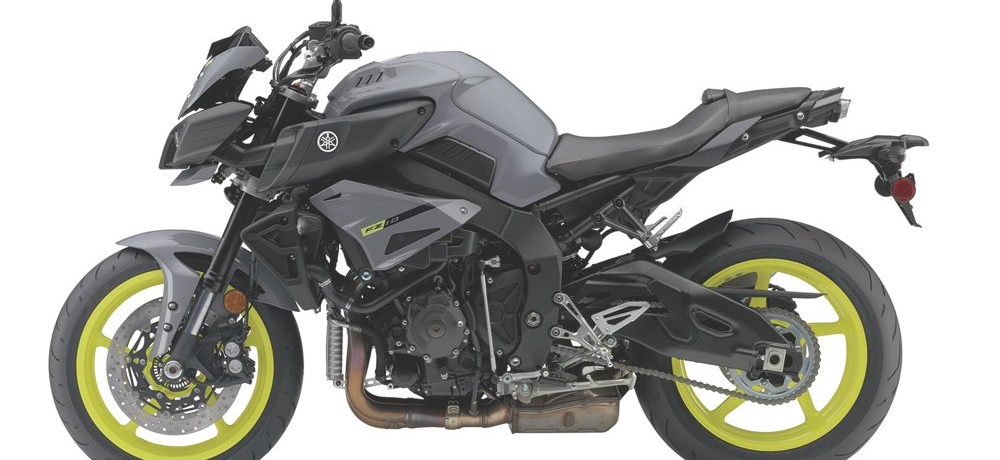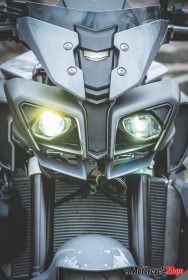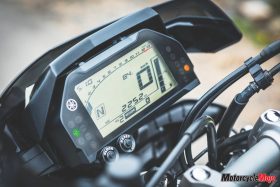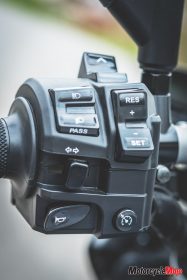Even if you’re not into futuristic styling, there’s no denying the 2017 FZ-10 is a force to be reckoned with
Strip a supersport machine of its bodywork and what do you get? Well, if you’re Yamaha and the bike you’re stripping is the R1, you get the outlandishly styled MT-10, introduced at EICMA late last year. The MT-10 seemed like one of those bikes reserved solely for a European audience, with styling maybe a bit too extreme for conservative, cruiser-friendly North America. Initially, it seemed that there was little chance we’d see it on this side of the Atlantic any time soon. However, Yamaha has decided to bring the MT-10 to Canada, though to keep its name in line with the other bikes in its lineup, the company has renamed it the FZ-10. And despite being available early this summer, it is slated as a 2017 model, replacing the half-faired FZ1, which was dropped from the lineup this year.
The spec sheet reveals that the FZ-10, which starts at $15,499, uses many of the same components that you’ll find on the recently released R1S, which itself is a lower-budget version of the R1. It uses the same frame and the same 998 cc crossplane engine as the R1, albeit in a different state of tune. Also borrowed from its supersport sibling are the gearbox, slipper/assist clutch, steering geometry, discs and calipers, and the suspension components. It uses a lower-cost and heavier steel subframe, though, instead of the R1’s cast magnesium item, thus repositioning the seat 30 mm lower, at 825 mm.
A Supersport Detuned
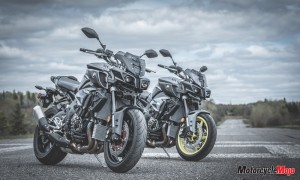 Most open-class naked bikes based on supersport machines, like the Aprilia Tuono, BMW S1000R, MV Agusta Brutale 1090 and Kawasaki Z1000, use detuned versions of the engines from their supersport equivalents, and the FZ-10 is no different. Its engine has been toned down to 158 hp from the R1’s 197 hp – at least according to European specs, since Yamaha Canada is guarded when publishing horsepower numbers, preferring not to. But more importantly, it has been tuned for a broader spread of torque at lower revs, which peak at 81.8 ft-lb at 9,000 rpm. That’s just 1.4 ft-lb less torque than the R1, but the peak arrives 2,500 rpm sooner, which is a real boon when riding around town.
Most open-class naked bikes based on supersport machines, like the Aprilia Tuono, BMW S1000R, MV Agusta Brutale 1090 and Kawasaki Z1000, use detuned versions of the engines from their supersport equivalents, and the FZ-10 is no different. Its engine has been toned down to 158 hp from the R1’s 197 hp – at least according to European specs, since Yamaha Canada is guarded when publishing horsepower numbers, preferring not to. But more importantly, it has been tuned for a broader spread of torque at lower revs, which peak at 81.8 ft-lb at 9,000 rpm. That’s just 1.4 ft-lb less torque than the R1, but the peak arrives 2,500 rpm sooner, which is a real boon when riding around town.
This revised output comes via lower-compression pistons (12:1 vs. 13:1), milder cams and smaller intake valves and ports, while the crankshaft and alternator rotor are heavier, thus contributing to the boost in low-end torque. The bike also utilizes a larger airbox and a different muffler. And to reduce costs, the engine covers are made of aluminum, as opposed to the R1’s lighter and costlier magnesium covers.
Electronic Aids
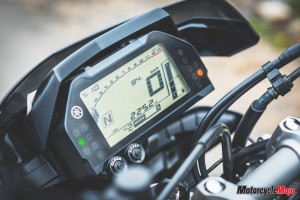 The FZ-10 has standard ABS, but unlike the R1S, the front and rear brakes are not linked. Yamaha’s variable throttle control system, dubbed “D-Mode,” features three selectable throttle maps: Standard mode, which is curiously the softest throttle mode; A mode, which sharpens throttle response at low to mid revs; and B mode, which offers the most aggressive throttle response. Why the throttle modes are organized in this order is a mystery even to the folks from Yamaha Canada, but it’s understood that an owner of an FZ-10 would become accustomed to it.
The FZ-10 has standard ABS, but unlike the R1S, the front and rear brakes are not linked. Yamaha’s variable throttle control system, dubbed “D-Mode,” features three selectable throttle maps: Standard mode, which is curiously the softest throttle mode; A mode, which sharpens throttle response at low to mid revs; and B mode, which offers the most aggressive throttle response. Why the throttle modes are organized in this order is a mystery even to the folks from Yamaha Canada, but it’s understood that an owner of an FZ-10 would become accustomed to it.
The FZ-10 has a simplified version of traction control, unlike the more elaborate system of the R1, which uses a lean-angle sensor. It has three selectable levels and can be turned off. While the FZ-10 doesn’t come with the R1’s wheelie, slide and launch controls, it does have a more street-friendly cruise control. The bike is also wired for an accessory electric quick shifter ($330), which permits clutchless, open-throttle upshifts.
Transformer-like
 Although the FZ-10 has been freed of the constraints of a fairing, the heavier engine and frame components do add some weight, with the FZ-10 weighing in at 210 kg wet, seven kilos heavier than the R1S and 11 kilos more than the R1. Replacing the fairing is a bug-eyed nosepiece that bears a striking resemblance to one of the Transformers characters – you know, the ones with the Hollywood movie franchise. After polling several friends, I believe it’s safe to say that the FZ-10 styling is quite polarizing, and you either love the look or you hate it. I fall into the latter category, which isn’t surprising, given I’m probably not part the youthful demographic the FZ-10 aims to woo. For me, the styling is just too busy, with too many angular covers, sharp lines and just too much clutter, though I admit that with time, I became a tiny bit fonder of the bluish-grey one with the bright yellow wheels. Just a tiny bit.
Although the FZ-10 has been freed of the constraints of a fairing, the heavier engine and frame components do add some weight, with the FZ-10 weighing in at 210 kg wet, seven kilos heavier than the R1S and 11 kilos more than the R1. Replacing the fairing is a bug-eyed nosepiece that bears a striking resemblance to one of the Transformers characters – you know, the ones with the Hollywood movie franchise. After polling several friends, I believe it’s safe to say that the FZ-10 styling is quite polarizing, and you either love the look or you hate it. I fall into the latter category, which isn’t surprising, given I’m probably not part the youthful demographic the FZ-10 aims to woo. For me, the styling is just too busy, with too many angular covers, sharp lines and just too much clutter, though I admit that with time, I became a tiny bit fonder of the bluish-grey one with the bright yellow wheels. Just a tiny bit.
Fortunately, there’s some redemption when you swing a leg over it. The tall, wide tapered aluminum handlebar (which replaces the R1’s clip-ons) puts you in a relaxed, upright riding position, and the redesigned exhaust has allowed designers to place the foot pegs lower than on the R1, though they’re still on the sporty side of high. The fuel tank rises high, giving the impression you are sitting on a much larger machine, though the bike feels light between your legs. The instrument panel is a high-tech LCD screen that displays a digital speedometer, bar-type tachometer, trip meter, fuel economy, gear indicator, ambient and coolant temperatures, ride modes and a few other items.
Hard Acceleration
Fire up the engine and a very characteristic exhaust drone that is unique to Yamaha’s crossplane inline-four greets you. The FZ-10 emits a low-pitched offbeat rumble that sounds more twin-like than four, and it’s actually quite a menacing sound. And the torque! The FZ-10’s smooth, flat power band and offbeat sound combine to belie the bike’s brutish acceleration, so when you twist the throttle, you’d better have a good grip on the handlebar. An enthusiastic twist of the throttle in the most aggressive B mode lifts the front wheel effortlessly in the lower gears, and in the higher gears gets the speedometer deep into the triple digits quicker than you might expect. The bike is, in fact, geared shorter than the R1 (43-tooth rear sprocket vs. 41), emphasizing acceleration over top speed. Power delivery is so broad and tractable, however, that the bike could probably do without the additional ride modes, and if in doubt, the traction control is there to save the day anyway.
The bike actually handles back roads even better than the supersport on which it is based thanks to the more relaxed riding position and increased leverage provided by the handlebar. Turning transitions are almost 600-class quick, though the bike does exhibit a slight twitchy nature, also due to its wide handlebar. On the highway it exhibits rail-like stability, though being a naked bike, long rides will be taxing owing to the lack of wind protection.
The suspension is fully adjustable at both ends, though I left it as delivered, which was about in the middle of its range, and on the firm, sporty side of the spectrum. A softer adjustment setup would probably be more appropriate for the daily commute, while a firmer setup would likely handle a fast track day pace with ease. And the bike is certainly capable of weekend jaunts at the local racetrack, especially if you install a set of sticky race tires.
Whatever you might think of the FZ-10’s appearance, Yamaha did the right thing to bring the bike into Canada. More and more riders are looking for supersport performance and handling in a more comfortable, less conspicuous package (by insurance standards anyway). In those respects, if you like the way the FZ-10 looks – and you’re out there according to my impromptu poll – it just might fit your needs. And by choosing the FZ-10 over the R1S, you not only get a bike with most of the supersport’s performance, you also get it in a more comfortable, more manageable package, and you’ll pocket about $1,200 to boot.









